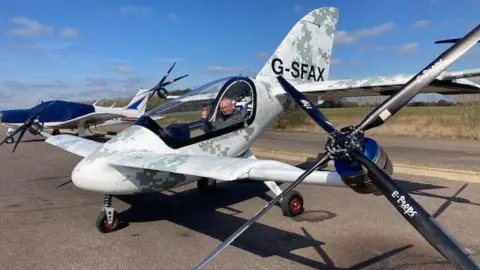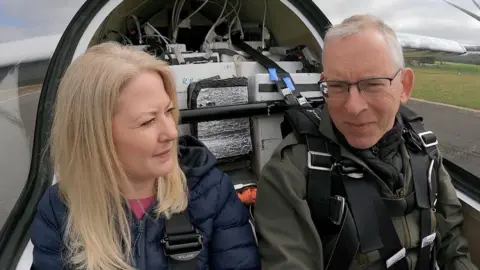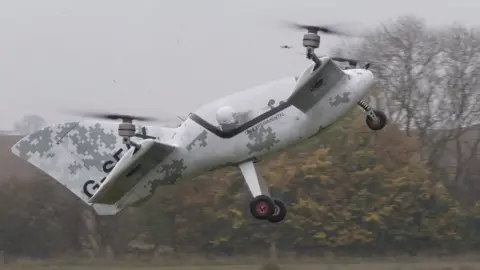Could electric drones you can sit in take off?
 BBC
BBCImagine an electric drone mixed with a fixed wing plane - that is the concept behind a new two-seater aircraft being developed by start-up company, Skyfly.
The Axe promises the flexibility of a helicopter but without the cost, noise pollution or carbon emissions.
It is a vertically capable aircraft, or Electric Vertical Take-off and Landing (eVTOL) aircraft, which means it can take off like a helicopter.
It also has two fixed wings that allows it to take off and land from a runway.
The company claims the Axe has a top speed of 100mph, it can carry up to 172kg - approximately the weight of two 13.5st adults - and has a range of 100 miles, about the distance from Oxford to the Isle of Wight.

The team, based near Banbury in Oxfordshire, has taken five years to fine tune the design.
"Compared to a conventional aircraft it's got eight motors which is very strange," says Dr Bill Brooks, Skyfly's chief technical engineer.
"And it's a tail-first layout called a canard so it's got the tail at the front. The all up weight is 750kg but 240kg of that are batteries so all the structure is carbon fibre to keep it as light as possible," Dr Brooks says.
Safety is an important part of the design too.
'Environmental benefits'
The large wings help it to glide in the event of power failure and there are two motors at the end of each wing so that if one fails the other can compensate.
It is also equipped with an emergency ballistic parachute to bring the aircraft and passengers down safely.
As well as being safer and cleaner than conventional aircraft, Michael Thompson, Skyfly's chief executive, says electric models are significantly quieter too.
"When you're taking off, you're no longer annoying everyone around you from a noise perspective, so I do think electric propulsion brings not only environmental benefits but from a noise pollution point of view, it's a huge benefit as well," he says.

Who is it marketed at?
Other eVTOLs under development include those looking to provide an electric flying-taxi service like Bristol-based Vertical Aerospace (VA) .
VA, as well as Archer and Joby in the US, are designing electric powered aircraft to carry up to four passengers.
Skyfly's Axe, by comparison, is more compact and aimed at the private market.
The do-it-youself kit-plane comes with a price tag of £250,000.
It is aimed at existing pilots who want to transition away from diesel piston engines.
Jason Pritchard, executive editor of eVTOL Insights, says it is also likely to appeal to flying clubs in order to train new members:
"The eVTOL aircraft industry is still in its infancy with initial operations a few years away, but it also needs to train large numbers of pilots in the coming years," he says.
"Additionally, the Axe's design can also train pilots with the skills and controls necessary to land an aircraft without power, which is a necessary tool."
 Skyfly
SkyflyWhat about charging infrastructure?
While the Axe can be charged up overnight with a conventional three-pin plug, just like EV cars, electric aircraft will need the charging infrastructure to be scaled up.
Aerovolt, based in West Sussex, has installed rapid chargers at seven UK airports with 40 more in the pipeline.
Its founder, Philip Kingsley-Dobson, says demand is growing.
"A lot of piston aircraft can't use leaded fuel in the future so they're looking for alternatives and ways we can decarbonise the lower end of aviation," he says.
'Cutting edge'
There are no eVTOL aircraft currently permitted to fly in the UK.
Skyfly's Axe has successfully completed manned test flights in both hover and forward flight modes but still needs to be certified by the Civil Aviation Authority (CAA).
With 40 pre-orders from buyers all over the world, the company hopes to deliver the new model to customers early next year.
A CAA spokesperson said: "We are working with innovators to test and fly brand new forms of aviation that keeps the UK at the cutting edge of flight technology and supports the sector to grow.
"New technology comes with new challenges and safety remains our priority in all this work."
You can follow BBC Oxfordshire on Facebook, X (Twitter), or Instagram.
